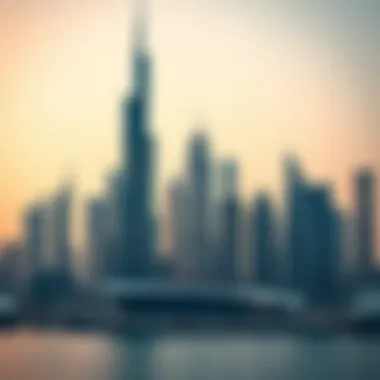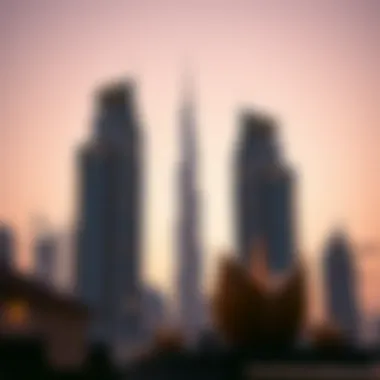Landmark Towers: Cornerstones of Dubai's Real Estate


Intro
Dubai, a city that epitomizes opulence and ambition, is renowned for its towering skyscrapers that reach for the heavens. Each landmark tower not only contributes to the skyline but also plays a crucial role in the city's real estate landscape. In this article, we will delve into the architectural significance, cultural resonance, economic impact, and investment potential of these iconic structures.
Understanding the importance of landmark towers helps clarify how they shape Dubai’s identity in the global market. From influencing urban development to altering lifestyle choices, these towers embody more than mere bricks and mortar.
Let's take a closer look at their influence in the real estate sector, particularly through market insights and investment opportunities that they present.
Understanding Landmark Towers
Landmark towers serve as more than just tall buildings; they are symbols of ambition, engineering marvels, and reflections of a city's aspirations. In the context of Dubai, these structures are significant to the real estate landscape, embodying not only architectural innovation but also economic vitality. Their presence in the skyline often encapsulates the identity of the city, speaks volumes about its culture, and carries influence far beyond the borders of the emirate.
The importance of understanding landmark towers in Dubai goes beyond the aesthetic appeal they provide. The characteristics that define such towers—height, design, and functionality—play a critical role in attracting investors, residents, and tourists alike. Beyond their unique silhouette and structural prowess, these towers often incorporate luxury amenities, modern technology, and sustainable practices. Thus, they stand tall as a prudent investment choice in varying economic climates.
As Dubai's skyline continues to evolve, it helps to consider:
- Architectural Features: The design elements that set apart these towers, including facades like Burj Khalifa's tapering silhouette.
- Cultural Impact: How these structures influence lifestyle and the perception of luxury and success, affecting local and expatriate communities.
- Economic Drivers: The role of landmark towers in pumping life into the real estate market, boosting property values, and attracting foreign investment.
In this light, understanding landmark towers provides a window into Dubai's past and future. It reveals how the city’s ambitions translate into concrete forms that shape social interactions, patterns of living, and even economic investments. A thorough exploration of their characteristics and evolution is crucial for homebuyers, investors, agents, and developers, as it offers a foundation for strategic decisions in real estate.
Definition and Characteristics
Landmark towers can be defined as tall buildings that stand out due to their height, architectural design, or cultural significance. These towers tend to become synonymous with their cities, often making their way into global conversations regarding urban development. In Dubai, landmark towers are not just structures; they are experiences that encompass living, working, and enjoying life at an elevated level.
Some key characteristics of landmark towers include:
- Height and Scale: Towers like the Burj Khalifa redefine what is possible in construction, reaching unprecedented heights that capture the imagination.
- Architectural Innovation: Designs are often avant-garde, utilizing materials and techniques that push boundaries, as seen in the sleek structure of the Burj Al Arab.
- Functionality: Beyond being visually striking, these towers often house luxury apartments, commercial spaces, and hospitality services, making them multifaceted in purpose.
Each tower contributes to the vibrancy of Dubai’s urban landscape, creating unique experiences for residents and visitors alike. By understanding these elements, one can appreciate the effect these towers have on the market and community engagement.
Evolution of Landmark Towers in Modern Architecture
The evolution of landmark towers in Dubai reflects broader trends within global architecture and the changing dynamics of urban spaces. Originally, structures prioritized form over function—think of grand cathedrals or classic skyscrapers like the Empire State Building. However, modern architecture has taken a different route, integrating sustainability, advanced technologies, and human-centric designs.
Historically, the rise of landmark towers in Dubai coincided with the economic boom of the late 20th century, transforming a desert landscape into a bustling metropolis. This shift was characterized by:
- Adoption of sustainable practices, incorporating green technology in energy usage and building materials-like with the Dubai Frame.
- Emphasis on community spaces, designing towers with mixed-use functionalities that encourage social interactions among residents, thus fostering a vibrant urban culture.
- Integration of technological advancements, using innovative construction methods such as prefabrication and smart building systems that enhance both efficiency and occupant experience.
Consequently, the evolution of landmark towers this way has not only contributed to their iconic status but also played a crucial part in reshaping perceptions on urban living. Understanding this evolution helps stakeholders make informed choices about investments and development trends within Dubai's competitive real estate market.
"Landmark towers are more than just buildings; they are beacons of aspiration, reflection, and the ever-changing narrative of urban identity."
The continuous evolution of landmark towers in Dubai encapsulates the essence of a global city driven by innovation and ambition.


Significant Landmark Towers in Dubai
Dubai is not just a city; it's a canvas of architectural ambition, and at the heart of this vibrant skyline lie its landmark towers. These structures are not merely impressive feats of design; they represent the socio-economic heartbeat of the city. The significance of these towers transcends their height and grandeur, impacting the real estate market, influencing tourism, and shaping the identity of this global metropolis.
Among the myriad benefits these towers offer, their role in driving economic development stands out prominently. Towers like the Burj Khalifa or the Burj Al Arab are not just homes or offices; they symbolize an invitation for investment, drawing in expatriates, businesses, and tourists alike. The sheer presence of these buildings can spike surrounding property values and attract high-end retail and dining establishments, which in turn fosters job creation and city growth.
When considering these magnificent structures, important factors come into play:
- Economic Growth: High-profile towers can significantly elevate adjacent real estate values.
- Cultural Domination: Many of these towers have become cultural icons, representing not just wealth but also the aspirations of a nation.
- Tourist Magnetism: Landmark towers often become key attractions for visitors, further boosting local economies.
In this section, we will delve deeper into some of the most significant towers in Dubai, exploring their unique characteristics and contributions to the city's real estate tapestry.
Burj Khalifa: More Than Just a Skyscraper
More than just a skyscraper, the Burj Khalifa stands as a testament to human ingenuity and ambition. It holds the title of the tallest building in the world, reaching a staggering height of 828 meters. But its significance is far greater than just a record-breaking structure. Burj Khalifa serves as a colossal beacon, drawing in visitors and investors from around the world. Its observation decks provide panoramic views of the sprawling city, making it a must-visit spot for tourists. The ambiance surrounding the tower, including the Dubai Fountain and surrounding parks, offers a luxury experience that complements the architectural marvel itself.
Burj Al Arab: The Icon of Luxury
Designed to resemble the sail of a ship, Burj Al Arab doesn’t just signify luxury, it embodies it. This 7-star hotel is a symbol of opulence and attracts a clientele that desires nothing less than the best. The building’s innovative design, combined with impeccable service, has cemented its status as a global icon. The Burj Al Arab not only contributes to Dubai's image as a luxury destination but also influences real estate trends by setting standards for high-end developments in the region.
Dubai Marina Towers: Urban Oasis
The Dubai Marina Towers encapsulate the essence of urban living. With their stunning waterfront views and strategic location in the Dubai Marina, these towers are framed by a lively community atmosphere. The development fosters a sense of belonging and lifestyle options for residents and investors alike. The Marina itself, lined with restaurants, shops, and parks, establishes an appealing environment that enhances property desirability. As a result, the demand for rental spaces in Dubai Marina remains robust, translating to a lucrative opportunity for investment.
The Address Downtown: A Symbol of Opulence
Standing majestically adjacent to the Burj Khalifa, The Address Downtown is not just a luxury hotel but an experience. Recognized for its architectural brilliance and exceptional services, it has become a defining feature of Dubai's skyline. This tower not only elevates the brand of luxury accommodation but also serves as a key player in the revival of the surrounding real estate market. Its influence radiates across nearby developments, reinforcing the idea that luxury and lifestyle are intertwined in Dubai's permanent landscape.
Economic Implications of Landmark Towers
Landmark towers in Dubai are not merely architectural marvels; they serve as beacons of economic vitality. These structures hold an undeniable significance in shaping the real estate landscape and driving the economic progress of the city. The sight of soaring skyscrapers against the horizon is more than just an aesthetic achievement; it's a symbol of investment potential and urban dynamism. Understanding the various economic implications of these towers is crucial for investors, homebuyers, and urban planners alike, as they provide valuable insights into the market dynamics and future growth trajectories of the real estate sector.
Impact on Real Estate Values
Dubai's landmark towers directly influence real estate values in the surrounding areas. High-profile buildings like the Burj Khalifa or the Burj Al Arab create an aspirational aura that raises property prices. When a distinguishing structure is situated nearby, it tends to attract not only tourists but also high-net-worth individuals seeking luxurious living spaces. This influx of interest can lead to skyrocketing property prices, providing significant returns for investors.
Moreover, properties in proximity to these towers typically experience increased demand. Features like world-class amenities, stunning views, and exceptional architectural design often come as part of the package for residences located near landmark towers. Consequently, the ripple effect can boost overall real estate values in adjacent neighborhoods.
- Factors influencing real estate value due to landmark towers include:
- High demand from affluent buyers.
- Rental price premiums for properties near iconic buildings.
- Enhanced local infrastructure such as roads and malls fueling further demand.
In essence, these landmarks perform dual roles: they enhance the city's aesthetic while simultaneously acting as catalysts for escalating real estate values, making them an integral aspect of Dubai's economic framework.


Role in Attracting Investments
Landmark towers often function as magnets for global investments. The architectural grandeur and innovative design of structures like The Address Downtown can draw the attention of foreign investors looking to tap into the vibrant Dubai market. When an investor sees a city represented by its iconic towers, it conveys a message of stability, prosperity, and forward-thinking.
Reasons why landmark towers catalyze investment include:
- Positive brand association with luxury and exclusivity.
- Increased foot traffic resulting in commercial opportunities around these developments.
- Attracting multinational corporations to set up offices, bringing more jobs into the local economy.
Additionally, governments and local authorities often provide various incentives to businesses that choose to establish themselves near these iconic structures. This further enhances their role as an investment hotspot.
Cultural and Social Impact
Landmark towers are not just impressive feats of architecture; they bear great cultural and social significance in Dubai's real estate landscape. These towering structures provide a backdrop for the evolving identity of the city, shaping the way residents and visitors perceive urban life. In examining the cultural and social impact of these iconic buildings, it becomes clear how they influence community interaction, lifestyle choices, and the overall atmosphere of city life.
Cultural Significance of Iconic Structures
Iconic structures represent more than mere buildings. They serve as symbols—not just of architectural ingenuity but also of cultural values and aspirations. The Burj Khalifa, for instance, stands as a testament to human ambition, while the Burj Al Arab represents luxury and exclusivity. These towers draw tourists, making them integral to Dubai's global image. The cultural significance extends into the everyday lives of residents as well, shaping a collective pride in calling such a vibrant, visually striking metropolis home.
"Iconic towers in Dubai do not just define the skyline; they define the spirit of the city itself."
This cultural essence is framed through local art, media, and events, which often celebrate these structures. For instance, cultural festivals often take place at or around these buildings, fostering community interaction and promoting local talent. This interconnectedness creates a sense of ownership among residents who take pride in their city's architectural marvels.
Influence on Lifestyle and Community Development
Landmark towers significantly affect the lifestyle choices available to residents and can transform communities around them. For example, neighborhoods featuring these towers tend to have enhancements in infrastructure, shopping, dining, and entertainment options. Areas like Dubai Marina, where numerous towering residential complexes exist, boast a vibrant lifestyle with waterfront promenades and a variety of leisure activities.
The integration of these towers into local neighborhoods can also lead to improved public spaces, parks, and community facilities. They encourage social interaction, providing open spaces where families and communities can gather. One could argue that the presence of such iconic structures serves as a catalyst for urban development, which in turn fuels the local economy and enhances the quality of life.
- Residential appeal: Life in proximity to these towers attracts young professionals seeking modern living spaces and amenities.
- Social hubs: Café culture thrives around them; people meet in vibrant downtown areas to engage socially.
- Transportation development: Projects often lead to enhancements in public transport, facilitating better access to urban amenities.
In summary, the cultural and social impact of landmark towers in Dubai is profound. They are not just structures, but rather foundational elements that shape the community and influence the lifestyle of millions who live in and visit this vibrant city. As these iconic buildings continue to evolve, they will likely remain at the heart of Dubai's cultural narrative, forming lasting connections among people, places, and experiences.
Investment Opportunities
Investment opportunities within Dubai’s landmark towers present a unique landscape influenced by the city’s rapid development and global appeal. For potential investors and homebuyers, understanding both the prospects and inherent challenges within this sector is essential. Landmark towers not only symbolize architectural grandeur but also represent substantial financial avenues that can lead to lucrative returns.
Real estate investments, particularly in prominent buildings, entail specific strategic benefits. Not only do landmark towers often appreciate in value due to their status and desirability, but they also possess the advantage of attracting high-profile tenants. Whether you’re leaning towards buying or renting, each option carries its own set of considerations.
Buying Versus Renting: A Strategic Analysis
The decision between buying and renting in Dubai's landmark towers is like choosing between a rock and a hard place—both paths have merit, but the right choice relies heavily on individual goals and financial situations.
- Buying:
- Renting:


- Long-term Investment: Ownership can be a powerful means to accumulate wealth, especially in a city like Dubai where property values tend to grow over time. Towers such as the Burj Khalifa offer not just a roof over one’s head but also a status symbol and an asset that could see significant appreciation.
- Tax Benefits: Depending on the jurisdiction, property ownership can yield various tax advantages that renters simply do not enjoy.
- Customization: Owning a property allows investors to make changes, whether for personal preference or as a method to increase rental yield in the future.
- Flexibility: Renting gives you the chance to explore different neighborhoods or even upgrade as your financial situation changes without the long-term commitment of ownership.
- Lower Initial Investment: Typically, renting involves less upfront costs compared to buying, which can free up capital for other investments. For expatriates, this option could be a practical choice without the burdens of ownership.
- Covered Maintenance: In most rental agreements, maintenance costs are absorbed by the landlord, saving you from unexpected expenses.
Both options also require a thorough analysis of the specific market conditions and the unique aspects of the selected tower. Evaluating the surrounding infrastructure, accessibility, and amenities can help inform whether to buy or rent.
Future Trends in Landmark Tower Investments
Looking ahead, landmark tower investments in Dubai are poised for dynamic evolution. A few trends that are starting to gain momentum include:
- Sustainability Initiatives: With a growing concern about the environment, future developments in landmark towers are likely to factor in sustainability features. Buyers and investors are increasingly drawn to properties with energy-efficient systems and green certifications.
- Smart Technologies: Incorporating smart home technologies will not just elevate the living experience but also enhance the building’s marketability. Towers equipped with advanced tech systems for security, maintenance, and energy management appeal to tech-savvy tenants and buyers.
- Diversified Use Spaces: The trend towards mixed-use developments is becoming more prevalent, with residential, commercial, and hospitality components integrated into one project. This diversification is appealing for investors as it provides multiple revenue streams.
"Investors must keep an eye on market trends and adapt quickly, the real estate landscape is ever-changing, and those who are proactive stand to benefit the most."
By keeping abreast of these trends, investors can better position themselves to capitalize on emerging opportunities within Dubai's real estate market. Understanding the nuances of investment strategies in landmark towers can make all the difference in navigating this lucrative landscape.
Challenges Facing Landmark Towers
The landscape of Dubai’s landmark towers is both awe-inspiring and complex. While these structures play a vital role in shaping the city's identity and attracting global investments, they are also not without their challenges. Understanding the hurdles these iconic buildings face is crucial for investors, developers, and community members alike. This section dives into the maintenance concerns and environmental issues that accompany these towering feats of architecture.
Maintenance and Upkeep Concerns
Keeping a landmark tower in prime condition is akin to tending a high-maintenance garden; it requires constant attention, meticulous care, and significant financial backing. The towering heights and intricate designs of buildings like Burj Khalifa demand advanced maintenance protocols that are not just standard practice but necessities. The lack of regular upkeep can lead to various issues:
- Structural Integrity: Over time, wear and tear can compromise the very safety of the structure. Cracks, water leakage and corrosion are just a few of the potential threats that can arise without proper care.
- Aesthetic Appeal: A building known for its stunning exterior, if neglected, can quickly lose its allure. The cost to repair a tarnished façade often outweighs the ongoing expense of regular maintenance.
- Visitor and Tenants Safety: High-rise buildings attract a large number of visitors. Any failures in the maintenance aspect can lead to accidents, ultimately affecting the property’s reputation and profitability.
In the context of Dubai, where tourism is a major economic driver, ensuring that landmark towers are well-kept is essential. Each tower serves not just as a locality but as a brand representing the emirate’s commitment to modernity and luxury.
Environmental Considerations
The majestic skyline of Dubai is not only a symbol of prosperity but also a beacon of environmental challenges. As much as these landmark towers signify architectural achievement, they also raise several concerns regarding sustainability and ecological impact. Real estate stakeholders must grapple with these considerations:
- Energy Consumption: High-rise buildings consume vast amounts of energy, from maintaining temperature levels to lighting. This leads to increased utility costs and carbon footprints, which are counterproductive to global sustainability goals.
- Waste Management: With large populations living and working in these towers, waste management becomes a pressing issue. Ensuring that waste is handled efficiently requires substantial infrastructure and awareness, pushing developers to invest in better systems.
- Biodiversity Impact: Erecting giant structures often disturbs local wildlife and disrupts natural habitats. The further we go up, the more we must be mindful of our carbon footprints and work toward developing green habitats alongside these towers.
"The responsibility of creating landmarks goes beyond the steel and glass; it involves safeguarding our environment for future generations."
Ending: The Future of Landmark Towers in Dubai
Landmark towers in Dubai sit at the crossroads of culture, economy, and modernity, and their future holds significant implications for the city’s skyline and its global stature. Despite past challenges, such as economic fluctuations and environmental concerns, the path forward is filled with potential.
Sustaining Iconic Structures
One key aspect of the future of these towers is how they are maintained over time. The Burj Khalifa, for instance, requires regular upkeep due to its height and unique structure. Advances in technology play a pivotal role here. Smart building technologies, which include energy-efficient systems and automated maintenance routines, are transforming how large buildings are preserved. For investors and developers, incorporating sustainable practices not only enhances the longevity of these iconic structures but also boosts their market appeal.
The benefits of sustainable structures extend beyond maintenance. A well-maintained landmark tower can become a symbol of prestige, attracting higher property values and premium tenants. By focusing on sustainability, stakeholders can ensure that landmark towers remain integral to Dubai’s identity while also addressing local and global environmental challenges.
The Remaining Potential of Dubai's Skyline
When it comes to the skyline of Dubai, it's not just about the buildings that already exist; it's also about the untapped potential. As city planners and architects look to the future, the possibilities are vast. Innovative designs, influenced by both local culture and global trends, are emerging. These new projects can create additional landmarks that resonate with both residents and tourists alike.
Moreover, as demand for housing and office space rises, there’s a golden opportunity for new landmark towers to emerge. The focus on mixed-use developments, which combine residential, commercial, and recreational spaces, marks a shift in urban living that can redefine Dubai's real estate landscape. This shift can cater to the lifestyle of expatriates looking for vibrant community spaces, thus enhancing their experience in the city.



